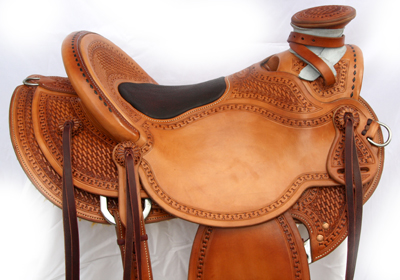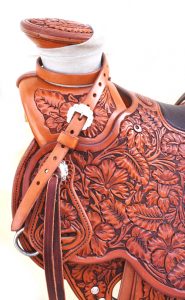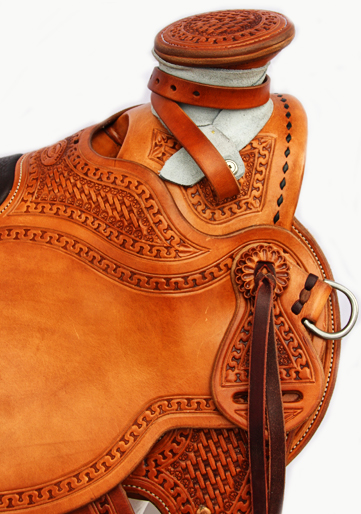Horse Gear & Makers, Online Exclusives
Andy Knight Saddlery
A custom built western saddle crafted by a skilled saddle maker to your specifications is simply the Rolls Royce of tack…and the cat’s pajamas. These unique leather treasures reflect, and are as varied as, the customers who order them, the horses who sport them, and the artisans who devote their lives to the craft of making them.
Andy Knight is a Canadian saddle maker whose shop is located in the Nicola Valley of British Columbia. He’s been in the custom saddle making business for over three decades. It is a small band of dedicated saddle makers in North America who work full-time to produce a modest number of individually crafted saddles annually for their livelihood. Each one employs his own approach to the work on his bench. Many, however, do not build their own trees. Beginning each saddle by custom crafting each tree is a part of the craft that Andy decided to embrace, and since 1991 all of Andy’s saddles have been built on his trees.
Andy got an early start in the saddle business. From adolescence, he felt drawn to horses and cowboy traditions although he admits his British immigrant family was very far removed from that kind of lifestyle. This interest prompted him to buy a Tandy leather craft kit.
 “I was probably 15 when I attempted to make a couple belts,” Andy says. “When I was 17 I had the opportunity to get a job in Calgary at Tex-Tan/Kenway. I worked there for less than a year. However, in that time I worked every spot on the saddle assembly line. I have always said, that’s where I learned how not to build saddles, but it gave me enough of a foundation that I could go out and start the learning process.”
“I was probably 15 when I attempted to make a couple belts,” Andy says. “When I was 17 I had the opportunity to get a job in Calgary at Tex-Tan/Kenway. I worked there for less than a year. However, in that time I worked every spot on the saddle assembly line. I have always said, that’s where I learned how not to build saddles, but it gave me enough of a foundation that I could go out and start the learning process.”
Andy began building saddles on his own in 1975. As he strove to improve his craftsmanship, a seasoned saddle maker agreed to critique his work.
“I used to build a saddle and I’d take it to him and he’d critique it,” Andy says. “Then I’d go home and build another, and he’d critique it. At that time I was in central Alberta but later we moved to B.C. I have spent the last 28 years here in the Nicola Valley which was a huge factor in my saddle making because the cowboy trade here was demanding a lot better quality saddle within the tree and the leather work than what I was producing. That drove me to find better trees, improve my saddle making skills, and so on.”
Many custom saddle makers depend on tree makers for the wooden skeletal structures underneath their leather creations. It’s not surprising when you consider that the tools and skills required to work with wood are not the same set used in the leather working aspects of saddle making. Thus, solo saddle makers can produce more saddles in a year if they don’t divert their time and resources to tree making and depend on other avenues for acquiring their trees.
 “I was like every other saddle maker,” Andy says about his early work. “I just bought trees from tree makers. Then the Wade became significant and the tree factories—especially at that time [the mid to late 1980s]—did not produce a Wade that I considered a Wade. I believe it was 1990, I went to Baker City, Oregon and paid Todd McGiffin to show me how to build trees. Prior to that, I had quit getting trees from the tree factories and I had three custom tree makers that built trees for me [Todd was one of those]. I had two other saddle makers working for me [at that time]. We built a significant amount of saddles. Then, almost simultaneously, those three tree makers quit.”
“I was like every other saddle maker,” Andy says about his early work. “I just bought trees from tree makers. Then the Wade became significant and the tree factories—especially at that time [the mid to late 1980s]—did not produce a Wade that I considered a Wade. I believe it was 1990, I went to Baker City, Oregon and paid Todd McGiffin to show me how to build trees. Prior to that, I had quit getting trees from the tree factories and I had three custom tree makers that built trees for me [Todd was one of those]. I had two other saddle makers working for me [at that time]. We built a significant amount of saddles. Then, almost simultaneously, those three tree makers quit.”
It was at this point that Andy was able to hire Todd and traveled to Baker City and learned to build trees.
“When I say, ‘learned to build trees,’” Andy explains, “that’s really the bare bones knowledge to where I could come home and possibly build a tree myself. It took a lot of work and practice, changing things, experimenting with things, and to this date I still do—looking at how the tree interacts with the horse, or a particular horse, and build something that will work.”
Andy presumes all saddle makers experience problems fitting saddles to particular horses. In his business, he says he caters to two different lines of thought, although they do interact.
“One is, ‘I ride multiple horses so I need a saddle that will work for those horses.’” he explains. “The other mindset is, ‘I have one horse and I want my saddle to fit that particular horse.’ So in the first case scenario I try and get a feel of the general type of horses that they’re riding and build what I refer to as a middle-of-the-road tree to fit those horses. For instance, if you’re riding all narrow Thoroughbreds, I would build you a different saddle than if you were riding typical average working Quarter Horses. We get fairly general there.
 “If you have, one horse that you want to fit and you want to get more specific, then we use the Dennis Lane profiling system which will profile a horse’s back in meaningful terms to me so that I can build a tree that will work for that horse’s back. Even though we may only be measuring that one horse, we’re building the saddle to fit that type of back. So, there’s going to be any number of horses within that range. If we start getting a specific horse or horses profiled, often the easiest way for them is to order a set of profiling cards themselves; I direct them to dennislane.com.au. Dennis Lane is from Australia and has put much thought into this system.”
“If you have, one horse that you want to fit and you want to get more specific, then we use the Dennis Lane profiling system which will profile a horse’s back in meaningful terms to me so that I can build a tree that will work for that horse’s back. Even though we may only be measuring that one horse, we’re building the saddle to fit that type of back. So, there’s going to be any number of horses within that range. If we start getting a specific horse or horses profiled, often the easiest way for them is to order a set of profiling cards themselves; I direct them to dennislane.com.au. Dennis Lane is from Australia and has put much thought into this system.”
The Dennis Lane system can be ordered through the above website and costs $75 plus shipping. It is a series of cards cut so that some look like Xs and others like rocking chair rockers which can be placed across and along a horse’s back. When snug fits are found for the appropriate points on the back, the corresponding numbers on the cards are recorded and then a tree can be made to those particular specifications. Andy is very familiar with this system and if correct profiling is done he can dial in the shape of a tree to properly fit most any horse’s back from a distance.
“Contrary to what people think,” Andy explains, “people talk about a saddle being like a shoe if it doesn’t fit. I would say it’s more like a sandal. It has a little more leeway in there because the saddle is sitting on the horse, you’re not shoving a horse into a saddle. There is always some leeway, and there’s some things that just don’t work. Anytime you saddle a horse and cinch it up and put weight on it you’re causing discomfort to one degree or another. It might be a slight discomfort all the way through to an unacceptable discomfort.”
Andy says that it is more of an art than a science to build a tree that will give optimum comfort to the horse while at the same time allowing the horse as much freedom to move as possible.
“It starts with the tree and then we go from there.” Andy says. “If the tree’s not going to work it doesn’t matter what leather work we do afterwards. All of my trees are made from wood. Usually I go up and find an appropriate log myself. I use old growth fir; we live in the ideal part of the world for that. I can saw up a log the way I want it sawn. And then it has to cure and dry.”
Andy covers his trees either with rawhide or fiberglass and epoxy.
 “Of course, rawhide is the traditional way of doing things,” Andy points out. “Fiberglass and epoxy is a more modern way, and both of them require the best materials and workmanship to make them right. The primary reason is strength. Wood is quite fragile because we thin it out quite a lot—like where you’re sitting, the bars there are quite thin. To withstand the stress of a wreck or roping, it needs to be very strong. Over the past few years I’ve been doing more with epoxy and fiberglass. It makes the saddle a little lighter in weight which can be beneficial because we build a lot of saddles for women. It’s also totally impervious to moisture. Even when we rawhide a tree we put coats of varnish on the wood before we rawhide it, and then after the rawhide is dry also put a couple coats of varnish on. We don’t want the tree to twist or move after the fact. One of the benefits of fiberglass and epoxy is that there’s no movement in the tree whatsoever in terms of twisting because of moisture.”
“Of course, rawhide is the traditional way of doing things,” Andy points out. “Fiberglass and epoxy is a more modern way, and both of them require the best materials and workmanship to make them right. The primary reason is strength. Wood is quite fragile because we thin it out quite a lot—like where you’re sitting, the bars there are quite thin. To withstand the stress of a wreck or roping, it needs to be very strong. Over the past few years I’ve been doing more with epoxy and fiberglass. It makes the saddle a little lighter in weight which can be beneficial because we build a lot of saddles for women. It’s also totally impervious to moisture. Even when we rawhide a tree we put coats of varnish on the wood before we rawhide it, and then after the rawhide is dry also put a couple coats of varnish on. We don’t want the tree to twist or move after the fact. One of the benefits of fiberglass and epoxy is that there’s no movement in the tree whatsoever in terms of twisting because of moisture.”
Andy occasionally teaches saddle fitting seminars. One of the points he likes to make in those is that, “What I’m going to say today is what I believe to be true today; if you ask me tomorrow I may not say the same thing because I’m always searching for clarity and more wisdom in all these things.” When it comes to saddle building, he doesn’t believe anyone can ever acquire all the wisdom or truth on the subject.
With the leatherwork, Andy says his goal is to make it as functional and artistically beautiful as he can.
“Whether it’s plain or fancy, in my mind it needs to be balanced and pleasing to the eye,” he says. “The body is constantly in motion both from the horse and the rider point of view. To fit that is an art form and then we take into consideration the person—their height, their weight—and then also how they wish to sit in the saddle. We all have an opinion of the correct way to sit, and they’re not all the same. I have my go-to, which would be more of your straight-up seat where your shoulders, hips, and ankles are all in line. However, not everyone wishes to sit like that, so as a saddle maker I have to work all that into consideration. The shape of the seat is dictated by the ground seat. We do an all leather ground seat; there’s no tin plate in there. It is built with multiple layers of leather and then shaped for the individual.”
People often ask Andy about warranties and guarantees on his saddles. Regarding the saddle fit, if he is involved with the fitting directly then he’ll guarantee that the saddle will work.
“One of the big factors that affects some saddle fit is the weight of the rider,” Andy says, “which adds to the complexity of getting things right. “If you have a 120 pound rider versus a 250 pound rider, the effect on the saddle to the horse can be quite different.”
Andy doesn’t have a legal guarantee on his trees, but explains that he has a verbal/handshake agreement with his customers and stands by his work to hold up under any normal usage.
 “I guarantee that the tree won’t break as long as it’s on top of the horse and the horse has his feet under him,” Andy says. “In other words, if you cartwheel down the mountain and the saddle breaks that’s no different than if you’re driving your car into a tree beside the road and complaining it broke.”
“I guarantee that the tree won’t break as long as it’s on top of the horse and the horse has his feet under him,” Andy says. “In other words, if you cartwheel down the mountain and the saddle breaks that’s no different than if you’re driving your car into a tree beside the road and complaining it broke.”
Building saddles one at a time may not be the road to riches, but Andy says it fits his approach as a craftsman. It also allows him to more flexibility in daily life to pick up and travel or go riding when such opportunities arise.
“I’m strictly a one-man shop,” Andy says. “I’m backed up usually in the eight month range. Which in the world of custom saddle makers isn’t huge, but I also build more than most one-man shops, especially considering I build my own trees, as well. Our upper end goal is 30 saddles a year. Generally we build between 25 and 30. The more artistic leather work involved obviously increases the time. A plain Jane rough-out saddle or a smooth-out is the quickest and least costly. From there, the sky is the limit. We build a variety of saddles from plain to full floral carved and from extra light to heavy working saddles.”
Andy says, he feels particularly honored to have worked with some highly respected horse trainers and clinicians who have influenced his craft and horsemanship.
For more info on Andy Knight’s saddles visit his website: www.knightssaddlery.com
To contact Andy Knight:
KNIGHT’S SADDLERY
2436 Aberdeen Rd. Lower Nicola, BC
V0K 1Y0 CANADA
Phone/Fax: (250) 378-5733
E-mail: KnightsSaddlery@gmail.com


